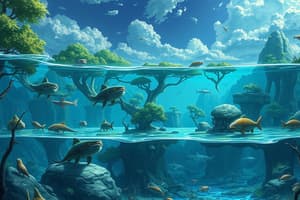Podcast
Questions and Answers
Which of the following best defines a food chain?
Which of the following best defines a food chain?
- A linear sequence showing energy transfer from producers to consumers. (correct)
- A complex network of interconnected food chains.
- A list of all organisms living in a specific habitat.
- A diagram showing the water cycle in an ecosystem.
Tertiary consumers are the first level of consumers in a food chain.
Tertiary consumers are the first level of consumers in a food chain.
False (B)
What is the primary role of producers in an ecosystem?
What is the primary role of producers in an ecosystem?
To convert solar energy into chemical energy.
The process of converting nitrogen gas into a usable form for plants is known as ________.
The process of converting nitrogen gas into a usable form for plants is known as ________.
Match the following cycles to their primary functions:
Match the following cycles to their primary functions:
Which of the following statements about herbivores is true?
Which of the following statements about herbivores is true?
Limiting factors can only be abiotic factors.
Limiting factors can only be abiotic factors.
What are two primary processes involved in cellular respiration?
What are two primary processes involved in cellular respiration?
What is the main difference between a physical change and a chemical change?
What is the main difference between a physical change and a chemical change?
Metalloids have properties that are similar to both metals and non-metals.
Metalloids have properties that are similar to both metals and non-metals.
What does the formula for density represent?
What does the formula for density represent?
_____ occurs when like charges repel each other.
_____ occurs when like charges repel each other.
Match the following celestial objects to their descriptions:
Match the following celestial objects to their descriptions:
Which of the following statements about electrical circuits is correct?
Which of the following statements about electrical circuits is correct?
Hydrogen peroxide decomposes into water and nitrogen.
Hydrogen peroxide decomposes into water and nitrogen.
What term is used to describe the movement of Earth around its axis?
What term is used to describe the movement of Earth around its axis?
Flashcards
Food Chain
Food Chain
A linear sequence showing energy transfer from producers to consumers.
Food Web
Food Web
A complex network of interconnected food chains in an ecosystem.
Producers
Producers
Organisms that make their own food through photosynthesis.
Herbivores
Herbivores
Signup and view all the flashcards
Carnivores
Carnivores
Signup and view all the flashcards
Sustainability
Sustainability
Signup and view all the flashcards
Tolerance Range
Tolerance Range
Signup and view all the flashcards
Limiting Factors
Limiting Factors
Signup and view all the flashcards
Physical Change
Physical Change
Signup and view all the flashcards
Chemical Change
Chemical Change
Signup and view all the flashcards
Density
Density
Signup and view all the flashcards
Specific Heat Capacity
Specific Heat Capacity
Signup and view all the flashcards
Metals
Metals
Signup and view all the flashcards
Non-metals
Non-metals
Signup and view all the flashcards
Metalloids
Metalloids
Signup and view all the flashcards
Periodic Table
Periodic Table
Signup and view all the flashcards
Study Notes
Food Chains and Food Webs
- Food Chain: A linear sequence illustrating energy transfer from producers to consumers. Example: Grass → Grasshopper → Frog → Snake → Hawk.
- Food Web: A complex network of interconnected food chains in an ecosystem.
- Trophic Levels: Different feeding positions in a food chain.
- Producers (Autotrophs): Convert solar energy to chemical energy (e.g., plants).
- Primary Consumers: Herbivores that eat producers (e.g., rabbits).
- Secondary Consumers: Carnivores/omnivores that eat herbivores (e.g., foxes).
- Tertiary Consumers: Top predators (e.g., eagles).
- Producers: Organisms that make their own food (e.g., plants, algae).
- Consumers:
- Herbivores: Eat only plants (e.g., deer).
- Carnivores: Eat only animals (e.g., lions).
- Omnivores: Eat both plants and animals (e.g., humans).
Sustainability
- Definition: The ability to maintain ecological processes over time.
- Concepts:
- Biodiversity is crucial for resilience.
- Avoid overexploitation of resources.
- Balance environmental, economic, and social factors.
Nitrogen, Water, and Carbon Cycles
- Nitrogen Cycle: Involves nitrogen fixation, nitrification, denitrification, and decomposition. Key terms: Ammonia, nitrate, nitrogen gas.
- Water Cycle: Evaporation, condensation, precipitation, runoff, infiltration, and transpiration.
- Carbon Cycle: Photosynthesis, respiration, combustion, and decomposition move carbon through the atmosphere, biosphere, oceans, and lithosphere.
Photosynthesis and Cellular Respiration
- Photosynthesis: 6CO₂ + 6H₂O → C₆H₁₂O₆ + 6O₂.
- Cellular Respiration: C₆H₁₂O₆ + 6O₂ → 6CO₂ + 6H₂O + Energy.
- Relationship: Photosynthesis stores energy; respiration releases it.
Tolerance and Limiting Factors
- Tolerance Range: The range of abiotic factors an organism can survive in.
- Optimal Range: Conditions where organisms thrive.
- Limiting Factors: Abiotic or biotic factors restricting population growth (e.g., temperature, water availability).
Matter and Mixtures
- Solution: Homogeneous mixture (e.g., saltwater).
- Compound: Two or more elements chemically combined (e.g., H₂O).
- Element: Pure substance of one type of atom (e.g., oxygen).
- Mechanical Mixture: Heterogeneous mixture (e.g., salad).
Physical and Chemical Properties
- Physical Properties: Characteristics observed without changing substance identity (e.g., density, color, boiling point).
- Chemical Properties: Describe reactivity (e.g., flammability, reactivity with acid).
Changes in Matter
- Physical Change: Changes state or appearance (e.g., melting ice).
- Chemical Change: Produces new substances (e.g., rusting).
Density Problems
- Formula: Density = Mass ÷ Volume.
Unusual Behavior of Water
- High specific heat capacity.
- Expands when frozen (less dense as a solid).
Metals, Non-Metals, and Metalloids
- Metals: Shiny, conductive, malleable (e.g., iron).
- Non-Metals: Dull, brittle, poor conductors (e.g., sulfur).
- Metalloids: Properties of both (e.g., silicon).
Periodic Table
- Families: Alkali metals, alkaline earth metals, halogens, noble gases.
- Trends:
- Atomic size decreases across a period.
- Reactivity varies (metals more reactive down a group).
- Atomic Number: Number of protons.
- Mass Number: Protons + Neutrons.
Bohr-Rutherford Diagrams
- Steps:
- Identify protons, neutrons, electrons.
- Draw nucleus with protons and neutrons.
- Add electrons in shells.
Molecular vs. Ionic Compounds
- Molecular: Nonmetals sharing electrons (e.g., H₂O).
- Ionic: Metals transfer electrons to nonmetals (e.g., NaCl).
Hydrogen Peroxide
- Decomposes into: Water (H₂O) and oxygen (O₂).
- Storage: Cool, dark conditions to prevent breakdown.
Law of Electric Charges
- Like charges repel, opposite charges attract.
Static vs. Current Electricity
- Static: Buildup of charges.
- Current: Flow of electrons in a circuit.
Charging Methods
- Friction: Rubbing materials transfer electrons.
- Conduction: Direct contact transfers charge.
- Induction: Nearby charged object induces charge.
- Grounding: Removing excess charge by connecting to Earth.
Circuits
- Components: Resistor, switch, battery, bulb.
- Symbols: Learn Chapter 13.1 symbols.
- Series vs. Parallel Circuits:
- Series: One path; shared voltage.
- Parallel: Multiple paths; equal voltage.
Efficiency and Energy
- Efficiency Formula: (Useful energy output ÷ Total energy input) × 100%.
- Electrical Power: P = IV (Power = Current × Voltage).
- Cost of Energy: Energy (kWh) = Power (kW) × Time (h).
Celestial Objects
- Meteoroid: Small rock in space.
- Meteor: Burns in Earth’s atmosphere.
- Meteorite: Reaches Earth’s surface.
- Asteroid: Rock orbiting the Sun.
- Comet: Ice and dust, tail forms near the Sun.
Planets
- Gas Giants: Jupiter, Saturn, Uranus, Neptune.
- Terrestrial: Mercury, Venus, Earth, Mars.
Earth’s Motion
- Rotation: Earth spins on axis (day/night).
- Revolution: Earth orbits Sun (year).
Satellites
- Natural: Moon.
- Artificial: Communication, weather, GPS.
Other Concepts
- Redshift: Light stretches as objects move away.
- Polaris: North Star; aligns with Earth’s axis.
- Eclipses:
- Solar Eclipse: Moon blocks Sun.
- Lunar Eclipse: Earth blocks sunlight from Moon.
Studying That Suits You
Use AI to generate personalized quizzes and flashcards to suit your learning preferences.




